
Summer Skin Care
When I was a youngster, my mom would take my brother, sister and me to the south shore of Long Island. She grew up near Chesapeake Bay and loved the water. Living there, she learned a lot about being in the sun and sunburns. The one thing she would insist on was each of us wearing a tee shirt and using sunscreen despite our protests.
Who doesn’t like the sunshine? The warm feeling the sun gives us makes us feel good. The lack of sunshine in winter can give us a type of depression called seasonal affective disorder. The day night cycle helps us sleep properly and get our rest. We need sun exposure to produce Vitamin D and give us strong bones.
Like anything else, we can get too much of a good thing and the sun is no exception. The skin is our largest sensory and protective organ and weighs 10 pounds. It is our connection to the outside world. It protects us from dehydration, infection, UV light, extreme heat and cold, chemicals and physical damage. It is on the job 24-7. It gives us those rosy red cheeks after being out on a cold day or a bad sunburn if we do not protect our skin from excessive sun at the beach. Our discussion today is about sun exposure and protection.
The sun causes many changes to the skin. Some are related to cancer and some to appearance. The UV radiation in sunlight is the most destructive part of the solar spectrum to our skin. Too much sun produces many changes and needs to be avoided to protect ourselves. Premature aging is a consequence of sun overexposure. Sun exposure can break down the connective tissue in the skin called elastin and collagen. When the connective tissue is damaged, the skin can sag and wrinkle. It can also lead to the formation of telangiectasias which are dilated blood vessels under the skin. Freckles and aging spots are also due to sun exposure. Blood vessels in the skin can become more fragile and more easily bruised. The skin can fix some of this damage but our ability to heal is less as we get older. The peeling of the outer layer of skin we see after we get a sunburn is an example of our skin repairing itself. Other strategies to reduce and repair some of the damage include exfoliation of the outer skin layer, hydration of the skin with topical preparations and bleaching aging spots.
Skin cancer is the greatest risk to our health from UV light overexposure. There are different types of skin cancer including:
- Basal cell cancer
- Squamous cell cancer
- Melanoma
- Actinic keratosis is a precancerous lesion that can also occur.
Different risk factors for skin cancer include
- UV light exposure especially at a young age and severe sunburns under age 18
- Fair or freckled skin
- Light colored eyes
- Red or blonde hair
- Family history of skin cancer
- Multiple moles or large flat moles with irregular shapes
- People with more pigmented skin have a lower risk of skin cancer but are still at risk.
The first 2 types of skin cancer account for 95% of cases and are highly treatable. These can appear as pink, brown or red, scaly, flat or raised lesions. They can bleed. Sun exposed areas such as the neck, arms, scalp and face are the most common areas involved. Treatments include local excision, cauterization, cryosurgery or freezing or topical creams.
Melanoma is a cancer of the pigment cells of the skin. This is a much more aggressive cancer and is very serious. If found and treated early, the prognosis is very good. It has a much higher risk of spreading to lymph nodes or other organs than the other 2 types of skin cancer. There are 5 warning signs of melanoma called the ABCDE’s.
The warning signs include:
- A – Asymmetry, the mole or dark spot does not look the same on either side if you draw a line through the center of it.
- B – Borders, the spot has irregular borders or the borders are not smooth
- C – Color, the spot has multiple colors or different shades
- D – Diameter, the spot is usually larger than ¼ of an inch
- E – Evolving, the spot is evolving or changing shape, size or color or any other characteristic.
Inspecting your skin and investigating any unusual or new skin lesions is the best way to find these early. If you have any questions, contact your dermatologist or primary care physician.
Prevention is the best course. Protecting your skin from the most intense sunrays is the best defense. Different methods include:
- Use a sunscreen that protects against UVA and B rays. You want to use sunscreen with a SPF, sun protective factor, of at least 15 and if you have fair skin even higher. Reapply the sunscreen liberally and when you get out of the water. The protective ingredients can break down over time so check the expiration date.
- Avoiding the direct sun from 10 am to 4 pm when the sun is most intense
- Wearing a hat or staying in the shade
- Avoid the tanning booth or beds. Use a spray or self tanner for the appearance you are looking for.
Recently, the use of PDE 5 inhibitors such as Viagra has been associated with an increased risk of Melanoma. This is preliminary information and further research is needed to confirm this. If you have questions, you should discuss this with your physician.
We usually think of summer as the time for sun protection but do not forget winter. Skiing, snowboarding and other outdoor winter sports can also expose you to the sun’s rays which are magnified by their reflection from the snow and higher altitudes. Sunscreen on exposed areas and eye protection are very important.
You cannot forget about eye protection. Bright sunshine over a prolonged period can damage your eyes. This damage can include cataracts and melanoma. Good sunglasses that block UVA and B are the best methods. Sunglasses can also help prevent damage to the sensitive skin around the eyes and prevent wrinkles.
We all love a beautiful day in the sun enjoying fun activities outside. I love going to the beach, pool, skiing or working in my garden. Prevention of sun overexposure is the best option. Use sun blocking products to reduce your risk. Check your skin or have a professional check it especially if you are in a high risk group. Avoid high risk behaviors such as using tanning booths or beds. Take the time to take care of yourself. YOU ARE WORTH IT.
I can still see myself sitting on the beach playing in the sand with my siblings or jumping the waves in my tee shirt. I did not always like my tee shirt but mom knew better. Thanks mom for looking out for me.
About the author:
 Dr Schutz was born in Newport News, VA and grew up in Flemington, NJ. He attended Rutgers University and New Jersey Medical School where he graduated in 1985. He was selected as a “Top Doc” in NJ Monthly Magazine and is the former President of the Medical Staff at Shore Memorial Hospital. He is married and has 3 children. He is active in religious and youth activities.
Dr Schutz was born in Newport News, VA and grew up in Flemington, NJ. He attended Rutgers University and New Jersey Medical School where he graduated in 1985. He was selected as a “Top Doc” in NJ Monthly Magazine and is the former President of the Medical Staff at Shore Memorial Hospital. He is married and has 3 children. He is active in religious and youth activities.

